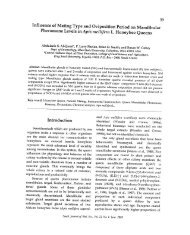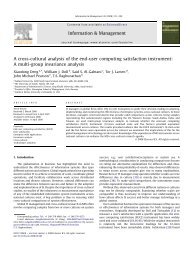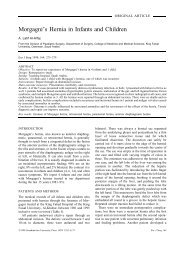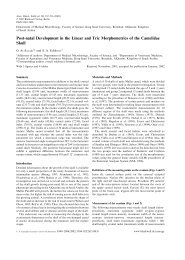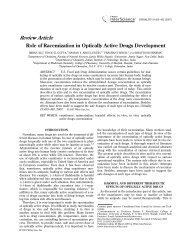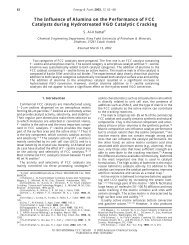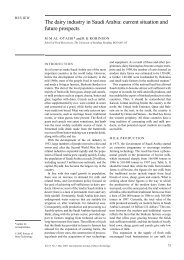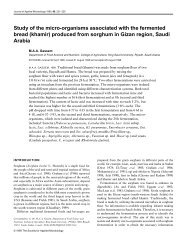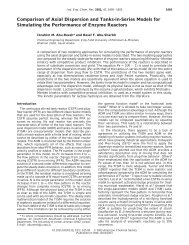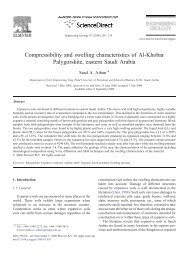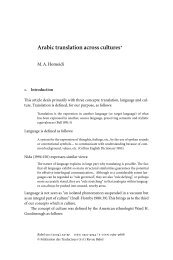Enslavement and Manumission in Saudi Arabia, 1926-38
Enslavement and Manumission in Saudi Arabia, 1926-38
Enslavement and Manumission in Saudi Arabia, 1926-38
You also want an ePaper? Increase the reach of your titles
YUMPU automatically turns print PDFs into web optimized ePapers that Google loves.
ALAINE S. HUTSON<br />
survey, they represented 59 percent of those who stated they had run away for<br />
family reasons.<br />
Slaves Released <strong>in</strong> the Prime of Life<br />
The statistics from <strong>Saudi</strong> <strong>Arabia</strong> <strong>and</strong> Bahra<strong>in</strong> revealed that <strong>in</strong> an overwhelm<strong>in</strong>g<br />
percentage of cases, slaves ran away <strong>in</strong> their prime. In this study, the de nition<br />
of ‘prime’ was between the ages of 15 <strong>and</strong> 45. For <strong>Saudi</strong> <strong>Arabia</strong>, 240 slaves<br />
reported their age. Of this number, 80 percent (n 5 195) were between 15 <strong>and</strong><br />
45 years of age. The mean age of freed men <strong>and</strong> freed women was 30.7, <strong>and</strong> the<br />
median was 30. The statistics for 188 runaways <strong>in</strong> Bahra<strong>in</strong> were similar; the<br />
percentage <strong>in</strong> their prime was higher, at 89 percent (n 5 167), but their mean age<br />
was 30, as was their median age.<br />
The slaves’ actions, runn<strong>in</strong>g away from their masters, suggest that they had no<br />
hope of be<strong>in</strong>g manumitted voluntarily dur<strong>in</strong>g this time <strong>in</strong> their lives. The close<br />
correspondence between the mean <strong>and</strong> median ages of <strong>Saudi</strong> <strong>Arabia</strong>n <strong>and</strong><br />
Bahra<strong>in</strong>i fugitive slaves <strong>in</strong>dicates that slaves <strong>in</strong> other Middle Eastern societies<br />
may have been manumitted only after they reached middle age <strong>and</strong> were less<br />
capable of physical labor.<br />
The two countries, however, showed a difference when gender statistics were<br />
compared. Gender had an effect on the age at which slaves ran away <strong>in</strong> <strong>Saudi</strong><br />
<strong>Arabia</strong> but not Bahra<strong>in</strong>. As Table 2 illustrates, the mean <strong>and</strong> median ages for<br />
women <strong>in</strong> both countries are similar to those of men. But a lower percentage of<br />
female slaves <strong>in</strong> <strong>Saudi</strong> <strong>Arabia</strong> were <strong>in</strong> their prime when they made the decision<br />
to run away. These statistics h<strong>in</strong>t at a problem that slaves might face <strong>in</strong> their<br />
older years, neglect. In 1930, Eldon Rutter, an expert on <strong>Saudi</strong> <strong>Arabia</strong>, documented<br />
this neglect:<br />
As we move along <strong>in</strong> the cloisters we see two or three very old men <strong>and</strong> women who<br />
look like bleary black skeletons. … These are the manumitted slaves—free men <strong>and</strong><br />
women. While they reta<strong>in</strong>ed suf cient strength to be of use they rema<strong>in</strong>ed slaves. But<br />
when they became too old to work any more they were set free <strong>and</strong> turned out to fend<br />
for themselves. … It is true that this heartless practice is seldom resorted to unless there<br />
is an additional reason for it. … But whatever the reason, the fact rema<strong>in</strong>s as another evil<br />
effect of slavery. … It is usual for slave-owners to keep superannuated slaves <strong>in</strong> their<br />
houses, <strong>and</strong> ma<strong>in</strong>ta<strong>in</strong> them until they die. 31<br />
While this neglect was visited on both men <strong>and</strong> women, Table 3 shows that<br />
women enslaved <strong>in</strong> <strong>Saudi</strong> <strong>Arabia</strong> were more likely to run away when they were<br />
over the age of 45 than men.<br />
In Bahra<strong>in</strong>, gender did not affect the older women’s rates of runn<strong>in</strong>g away. A<br />
chi-square test of gender’s effect on the age of fugitive slaves <strong>in</strong> <strong>Saudi</strong> <strong>Arabia</strong><br />
31 Eldon Rutter, Slavery <strong>in</strong> <strong>Arabia</strong> (London: Bill<strong>in</strong>g & Sons, 1933), p. 8.<br />
56



